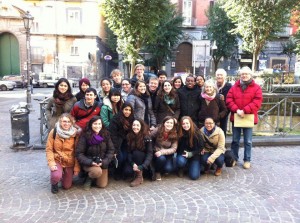Many of the Cornell in Rome blog posts have dealt with our travels, our breaks, and our wonderful food nights. However, we are still students studying here in Rome. With this post, I hope to show at least what the planners have been doing in the workshop course that we have. (For planning students the workshop course is our required intensive 6-credit course that we take while we are studying in Rome).
The past several weeks urban planning students have been working on neighborhood studies of four different neighborhoods in Rome: Eur, Val Melaina, Villa Gordiani, and Quarticciolo. We spent weeks interviewing residents finding out about neighborhood issues, neighborhood facilities, the history of each of the neighborhoods, and community associations and involvement. We looked into the current and future needs of the neighborhood through our resident interviews and also through our own group assessments of the neighborhood. We conducted surveys that included quantitative and qualitative measures to describe building typology, land-use, street typology, and several other assessments. Overall the work was very rewarding, and definitely gave me an experience that I could not get anywhere else.
Of course we all did have our difficulties. One challenge that we all realized rather quickly was the issue of communication. Many of us clearly could not speak Italian at a proficient level, and so a majority of us relied on our professors and teaching assistants for translations during several instances of speaking with residents and stakeholders in the neighborhood. Another challenge was making sure that we properly understood issues in terms of Italy as compared to many of our own backgrounds coming from the United States. Many of our neighborhoods were in borgate (peripheral neighborhoods of Rome) that did lack a lot of key services and wealth. However, unlike the United States, these neighborhoods still had plenty of access to fresh foods, (the food markets were tremendously cheaper than grocery stores), and despite their peripheral nature, they still were well-served by trams and buses. In the United States many poorer neighborhoods lack quality access to fresh foods and vegetables, markets are often expensive and unaffordable for many people, and public transportation is not very good especially in the periphery of cities.
The week before we submitted our compiled 60-100 page reports (that includes the appendix) we went on neighborhood visits of all the different neighborhoods. My neighborhood was Eur, which unlike the other neighborhoods was built to be a model city planned under Mussolini. The other neighborhoods on the other hand grew as a result of Mussolini pushing poorer residents outside the center of Rome into peripheral areas. Their histories clearly shaped the neighborhoods as they are seen today. Many of the residents in several of these neighborhoods really connect to their neighborhood histories in terms of how they see the future of their neighborhoods. Our reports delved into this area and a number of other areas in analyzing our neighborhoods. We plan to highlight the totality of our research and our final reports in our final exhibition in mid May.

Now that the urban planners have finished final reports of the specific neighborhoods we are on to our next assignment. All of us have split off into project groups to focus on certain topics and themes in Rome that we wish to explore in greater detail. My next project group is focusing on bicycles and the bicycle share system in Rome. Other project groups are focusing on issues such as placemaking by immigrant communities in Rome, Tiburtina station and its regional connections, water resources in Rome, and another group is looking into the Romani in Rome. These topics are definitely very focused, but the context that we are looking into deals with a large part of Rome, or all of Rome for that matter. What I really like about this project and the previous projects is how we are combining our research with practical experience. To compile our neighborhood reports we explored our individual neighborhoods and conducted neighborhood analyses with residents and stakeholders. With our next report we are also interviewing certain key contacts that deal with the issues we are exploring and for many of us we are going out into the field to conduct field assessments.
